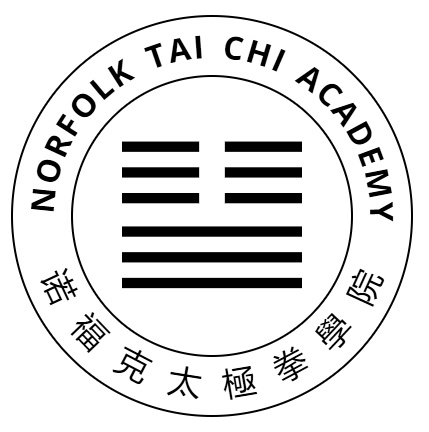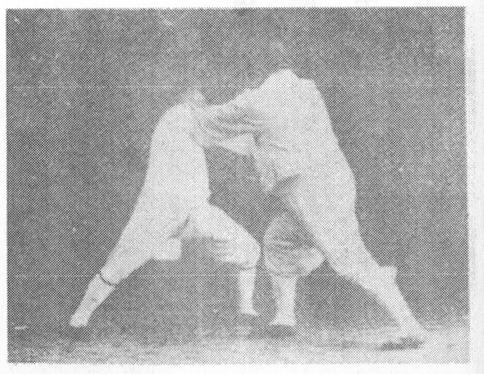There are two short weapons in taiji: the sword (劍 ) and the sabre (刀 ). The is a light, straight, double-edged sword, the choice of the nobility and of religious, requiring a high level of skill and a still mind.
By contrast, the is a heavier, curved blade with a single cutting edge. In China it is said: Jian is like a flying phoenix; dao is like a ferocious tiger. The sabre, having a simpler technique, is the “root of the short weapons” – the first short weapon to be trained. Whilst it lacks the subtlety of the straight sword it should not be underestimated; it too fosters the development of high level skills.
The word means simply knife, which is one reason why the Chinese remain so resistant to the Western knife and fork at their dining table. (flat tone) is not to be confused with (falling tone) 道 (formerly written tao) – the way.
The sabre set has many benefits. Most obviously, it exercises the shoulders – helping to open the upper gate.
The weight of the weapon helps with sitting and promotes a unified, whole body movement: it is simply too difficult to wave a heavy weapon around just with arm strength. Sabre play thus improves our empty-handed form. A typical wooden practice sabre weighs a pound and a metal sabre two to three pounds, but the Yang family practiced with sabres that weighed at least five pounds, so for our purposes the heavier the better.
There are many different sabres in China. The word dāo is also used for the halberd, a sabre on the end of a long pole that was used by infantry to defend against cavalry. But even the sabre proper has many different varieties.

Today we most commonly see the oxtail sabre ( 牛尾刀), a staple of Kung Fu movies (just look at Michelle Yeoh in the still above from “Crouching Tiger, Hidden Dragon”). This is a heavy weapon with a broad blade, for which reason it’s sometimes called a broadsword in English. It appeared in the 19th century as a civilian weapon (even an untrained person can do a lot of damage with one) at a time when firearms had made armour redundant and was never issued to the military. Because of the flare at the end of the blade, the centre of gravity of the oxtail sabre is not very close to the hilt, making it a powerful slashing weapon at the expense of manoeuvrability.
The oxtail sabre was also not the traditional choice in Taiji. Yang style sabre continues to use the willow leaf sabre 柳葉刀), which has a gentle curve along its entire length and often a curved handle as well. This developed from the goose feather sabre ( 雁翎刀 , see the photo below), which in turn developed from an earlier weapon used on horseback by the Mongols – the weapon that made the Mongol horde under Genghis Khan so feared and effective. These weapons are not broadswords but occupy a middle ground between a straight sword and an oxtail sabre – much narrower than the latter. The guard was very small; one can see instantly the similarity to the Japanese katana.

The oxtail sabre is however popular among Kungfu stylists and that’s why wooden sabres are made after the pattern of the oxtail sabre. It would be better to use a wooden willow leaf sabre but they are simply not available.
Sabre techniques: attacking
The sabre, like the straight sword, can be used to stab: either superficially (poke), or a deep thrust ( 刺). Most often it is used to chop – a powerful cut designed to cut through leather armour or to attack the neck. Chopping with the sabre is normally done at an angle ( 砍), a movement called throwing the shuttle, but can also be straight down ( 劈, hack).
The sabre is also used to slice ( 划), a method of attacking unarmoured parts of the body such as the hand or wrist, or the leading leg. It’s not necessary to cut off the opponent’s hand: it’s sufficient to make him drop his weapon. We see slicing of the hand at the end of Hide Sabre and Push as the weapon is held horizontally and pulled back towards the waist.
Finally the opponent can also be attacked with the hilt, for example with a blow to the temple (hit tiger left) or to the ribs (hit tiger right).
Sabre techniques: defending
In taiji sabre, stabbing attacks are blocked by neutralizing the incoming blade – deflecting and sticking to the blade (a taiji skill developed in push hands). According to one story, a famous sabre player known as Magic Sabre Zhang once had a bout with Yang Jianhou (son of Yang Luchan and father to Yang Chengfu). Armed only with a horsetail duster, Yang easily defeated Zhang by sticking to his blade, leaving Zhang unable to deploy any of his techniques.
When the blade is deflected one can move either inside (i.e. to the side of the opponent’s body) or outside the attack. Moving inside it is then simple to switch to attacking with an upper cut. Moving outside, one then spins round to attack (a movement not seen in our set).
Chopping attacks are avoided by holding the hilt high with the blade at an angle (a structure described as resembling a roof), such that the incoming blade is deflected to the side (as in roll the sabre).
An incoming sabre can also be blocked using sheer strength, and followed up by a push involving both arms, with the back of the blade being pushed by either the empty hand or the back of the empty forearm.
Don’t think that sabre techniques are necessarily designed to block another sabre. The opponent may have a spear. In this case, the defender must first intercept the attack and then rapidly close the distance, perhaps with a lunge.
In taiji the weapon is mostly held with a single hand, with a two handed grip used relatively seldom. Occasionally the other hand is used to reinforce a technique, which also keeps it out of harm’s way. This does not mean that the empty hand never does anything: it can also strike or grab.
Rolling the sabre
Rolling the sabre 纏頭 is a move that allows defence to shift to counterattack. An incoming chop is deflected down to the left. The sabre then rolls 纏 around the back of the head 頭 and strikes down in a diagonal chop (throwing the shuttle), or cuts horizontally ( 斬) – literally, behead). The full movement is then called, rather graphically, 纏頭裹脑 which means roll-head-wrap-brain! Note that in Mr Moy’s taijidāo the initial deflecting block is used to extend the spine, pressing down with the lower palm and stretching up with the upper hand.
Hiding the sabre
Any movement in which an opponent cannot see the sabre is called hiding or concealing ( 藏) the sabre. In our form, after rolling the sabre and throwing the shuttle, the path of the weapon is reversed and the weapon is held behind the spine as if being sheathed in a scabbard on one’s back. This is the main kind of hiding the sabre but the weapon is also “hidden” if, for example, it is held horizontally as we stand side on to an opponent, such that they can only see the handle.
In the next part of this article we’ll look at the Yang Sabre Set, before concluding with a third part looking at the set taught by Mr Moy.
References
Books and articles
- The Complete Taiji Dao, Zhang Yun, 2009



 I searched the internet for
I searched the internet for 

 This makes sense, but perhaps there’s more to it than this. As ever, the question to ask is: What would a Chinese person understand by the name of this move?
This makes sense, but perhaps there’s more to it than this. As ever, the question to ask is: What would a Chinese person understand by the name of this move?


 In the
In the 
 So now we know who the girl was, but why does she crop up in the name of a Tai Chi movement? Perhaps this story of a heavenly girl and an earthly boy has some kind of allegorical significance for the Taoists?
So now we know who the girl was, but why does she crop up in the name of a Tai Chi movement? Perhaps this story of a heavenly girl and an earthly boy has some kind of allegorical significance for the Taoists?